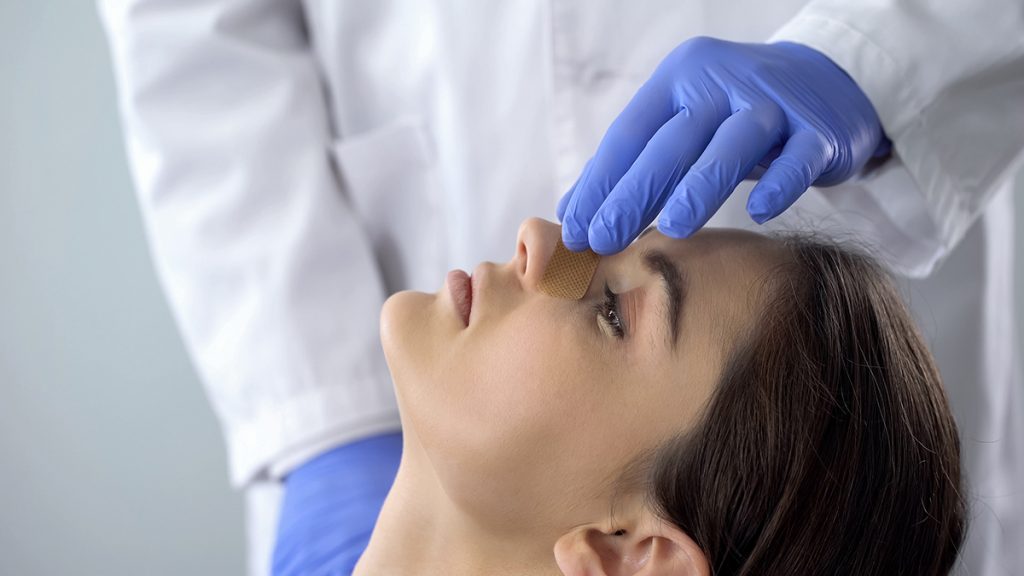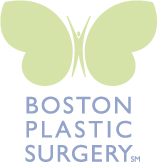Your nose is a prominent feature on your face, so if you’re unhappy with the size or shape of your nose (or the appearance of your nose changed after an injury), it’s almost impossible to hide. Whether you wish to reshape your nose for aesthetic reasons, improve functionality, or both, Boston female plastic surgeon Dr. Alannah Phelan uses rhinoplasty to create or restore a natural, more balanced nasal contour.
What is rhinoplasty?
Rhinoplasty, commonly referred to as a “nose job” or nose reshaping surgery, is a surgical procedure Dr. Phelan uses to alter the shape, size, or proportions of the nose. This surgery is one of the most transformative procedures in plastic surgery because of its ability to enhance facial harmony and boost self-confidence. Rhinoplasty is customized to each patient’s goals and anatomy.
What rhinoplasty can address
Rhinoplasty is tailored to enhance facial aesthetics depending on your goals. Common nasal features patients wish to improve include:
- Wide nose
- Large nose (overprojection)
- Wide nasal tip (boxy or bulbous)
- Dorsal hump (bump on nose in side view)
- Deviated or twisted nose
- Nasal asymmetry
- Drooping tip
In a revision rhinoplasty patients may need a combination of treatments which may include adding nasal tip support, treatment of breathing problems, or corrections of asymmetry.
Dr. Phelan will discuss your concerns and examine your nose before explaining what alterations can be made to your nose to help your vision for your nose be realized.
Good candidates for rhinoplasty
Good candidates for rhinoplasty are individuals who are in good overall health, have realistic expectations about the outcomes, and are seeking improvement rather than perfection. Typically, candidates are adults or teenagers whose facial growth is complete.
Rhinoplasty should not be used to make your nose look like someone else’s. The goal of nose surgery is to alter the nose so that it brings balance to your face and is more proportionate to your other features, while also preserving or improving vital nose functions.
The rhinoplasty procedure
Anesthesia
Dr. Phelan performs rhinoplasty under general anesthesia. You will be asleep and completely numb during surgery and feel no pain.
Surgery
An open rhinoplasty involves a small incision made in the columella, which is well hidden once healed. The procedure typically lasts between two and three hours, depending on the complexity.
Recovery and aftercare
Immediately after surgery, Dr. Phelan places a nasal cast on the nose to support the bones, cartilage, and tissue as they heal into their new shape and position. You’ll place ice gauzes to your eyes for about 24 hours to help relieve expected swelling and bruising in the eye area. Much of the swelling and bruising will gradually subside after the first week of recovery.
You’ll be asked to sleep on your back with your head elevated with 2-3 pillows for at least 4 weeks. Some patients opt to sleep in a recliner to easily maintain an elevated position and lower the risk of turning over and putting pressure on their nose in their sleep.
Dr. Phelan will remove the nose cast and external sutures at your 1-week follow-up appointment. Nasal swelling improves gradually, with significant improvements after 2 months, however complete resolution of swelling may take 12-18 months or longer depending on your anatomy and procedure.
- Key Benefits
- Glossary
- Enhances the overall look of the nose by reshaping or resizing it to achieve better facial harmony and balance
- Can correct a deviated septum and improve nasal airflow
- Repairs the shape and function of the nose after injuries
- Nose job: Refers to rhinoplasty, a common plastic surgery procedure aimed at reshaping or resizing the nose.
- Nonsurgical rhinoplasty: A cosmetic procedure using dermal fillers to alter the shape of the nose without surgery.
- Plastic surgery: A medical specialty that includes various procedures, such as rhinoplasty, to enhance or reconstruct body parts.
- Plastic surgeon: A medical professional trained and certified to perform plastic surgery procedures, including rhinoplasty.
- Nose surgery: A general term for any surgical procedure performed on the nose, such as rhinoplasty or septoplasty.
- Cosmetic surgery: A subset of plastic surgery focused on improving appearance, with rhinoplasty being a common example.
- Open rhinoplasty: A rhinoplasty technique involving an incision across the columella to provide the surgeon with a better view of the nasal structures.
- Nasal septum: The structure that divides the nasal cavity, often corrected during rhinoplasty to improve breathing.
- Healthcare provider: A broad term for professionals who offer medical services, including those who perform rhinoplasty.
- Nasal reconstruction: Surgical procedures aimed at rebuilding the nose, often part of rhinoplasty for trauma or congenital defects.
- Nasal bones: The bones forming the bridge of the nose, which may be reshaped during rhinoplasty.
- Facial plastic surgery: A specialized area of plastic surgery focused on the face, including rhinoplasty to enhance facial features.
- Dorsal hump: A bump on the nasal bridge that can be smoothed out during rhinoplasty for a straighter profile.
- Closed rhinoplasty: A rhinoplasty technique where all incisions are made inside the nostrils, leaving no visible scars.
- Deviated septum: A condition where the nasal septum is off-center, often corrected during rhinoplasty to improve airflow.
- General anesthesia: A type of anesthesia used during rhinoplasty to keep the patient unconscious and free of pain.
- Nasal skin: The outer covering of the nose, which is lifted and redraped during rhinoplasty to achieve the desired shape.
- Facial features: The distinct characteristics of a person’s face that can be harmonized through rhinoplasty.
- Soft tissues: The muscles, fat, and skin around the nose that are manipulated during rhinoplasty.
- Nasal skeleton: The bony and cartilaginous framework of the nose that is reshaped during rhinoplasty.
- Lateral cartilages: The cartilages on the sides of the nose that may be adjusted during rhinoplasty for better shape and function.
- Nasal tip: The lower part of the nose that can be reshaped during rhinoplasty for a more refined appearance.
- Functional rhinoplasty: Rhinoplasty performed to correct breathing issues and improve nasal function.
- Dermal fillers: Injectable substances used in non-surgical rhinoplasty to alter the shape of the nose without incisions.
- Reconstructive surgery: Procedures aimed at restoring function and appearance, which can include rhinoplasty for trauma or defects.
- Nasal defect: An abnormality in the nose’s structure, often corrected through rhinoplasty.
- Aesthetic nasal subunits: Specific regions of the nose considered during rhinoplasty to ensure a harmonious result.
- Paramedian forehead flap: A surgical technique using tissue from the forehead to reconstruct the nose, often in extensive nasal reconstructions.
- Cartilage: The flexible tissue that shapes the nose, commonly reshaped during rhinoplasty.
- Risks: Potential complications associated with rhinoplasty, such as infection, bleeding, or dissatisfaction with results.
- Cavernous sinus: A large vein in the skull near the nose, relevant to the anatomical considerations during rhinoplasty.
- Pterygopalatine ganglion: A nerve cluster near the nose that may be considered in rhinoplasty procedures.
- Facial nerve: A nerve affecting facial movement that must be carefully managed during rhinoplasty.
- Subunits and segments: The different areas of the nose and face considered in rhinoplasty for balanced results.
- Otolaryngologist: A specialist in ear, nose, and throat conditions who may also perform functional rhinoplasty.
- Cribriform plate: A part of the skull near the nose, important in the anatomical considerations for rhinoplasty.
- Greater superficial petrosal: A nerve related to facial anatomy, relevant to comprehensive rhinoplasty planning.
- The paramedian forehead flap: A surgical technique using tissue from the forehead to repair significant nasal defects.
- Lacrimal gland: A gland near the nose involved in tear production, relevant in detailed anatomical planning for rhinoplasty.
- Platyrrhine: A term describing a nasal shape.
- Nasal valve: The area within the nasal passage that can be adjusted during rhinoplasty to improve airflow.
- Turbinate: Structures within the nasal passage that can be resized during rhinoplasty to improve breathing.
- Hyperleptorrhine: Describes a specific nasal shape.
- Carotid artery: A major blood vessel.
- Parasympathetic nerves: Nerves that control certain involuntary functions.
- Nasal dorsum: The length of the nose’s bridge, often reshaped during rhinoplasty.
- Revision rhinoplasty: A secondary procedure to correct or enhance the results of an initial rhinoplasty.
- Septoplasty: A surgical procedure to correct a deviated septum, often performed alongside rhinoplasty.
- Anatomy of the human nose: The complex structure of the nose, essential knowledge for performing effective and safe rhinoplasty.
Rhinoplasty recovery timeline
Most patients can return to work and most normal activities within one to two weeks, although you will still have some visible swelling and some bruising. Strenuous activities and exercise should be delayed for at least six weeks to prevent excessive swelling, which can impact your results. As each month goes by, you notice less swelling and watch your final nose appearance take shape.
Results
While you will look “normal” shortly after surgery, your nose will be very close to its final appearance after about 3-6 months. It can take up to 1 year for residual swelling to completely resolve.
Choosing the right surgeon for your nose surgery
Selecting a highly skilled and experienced plastic surgeon is crucial when undergoing any procedure, particularly for any surgery to the face. Surgeons like Dr. Phelan have trained extensively in facial plastic surgery procedures and have the meticulous surgical skills to achieve remarkably natural rhinoplasty results while ensuring the vital functions of the nose are maintained or improved.
Rhinoplasty FAQs
References »
Crosara PF, Nunes FB, Rodrigues DS, Figueiredo AR, Becker HM, Becker CG, Guimarães RE. Rhinoplasty Complications and Reoperations: Systematic Review. International Archives of Otorhinolaryngology. 2017. doi: 10.1055/s-0036-1586489.
Kalantar-Hormozi A, Ravar R, Abbaszadeh-Kasbi A, Rita Davai N. Teenage Rhinoplasty. World Journal of Plastic Surgery. 2018.
Nellis JC, Ishii M, Bater KL, Papel ID, Kontis TC, Byrne PJ, Boahene KDO, Ishii LE. Association of Rhinoplasty With Perceived Attractiveness, Success, and Overall Health. JAMA Facial Plastic Surgery. 2018. doi: 10.1001/jamafacial.2017.1453.
Parrilla C, Artuso A, Gallus R, Galli J, Paludetti G. The role of septal surgery in cosmetic rhinoplasty. ACTA Otorhinolaryngologica Italica. 2013.
To learn more about how nose surgery in Boston can transform your appearance, schedule your consultation with female facial plastic surgeon Dr. Alannah Phelan. Please call Boston Plastic Surgery at (617) 786-7600.


